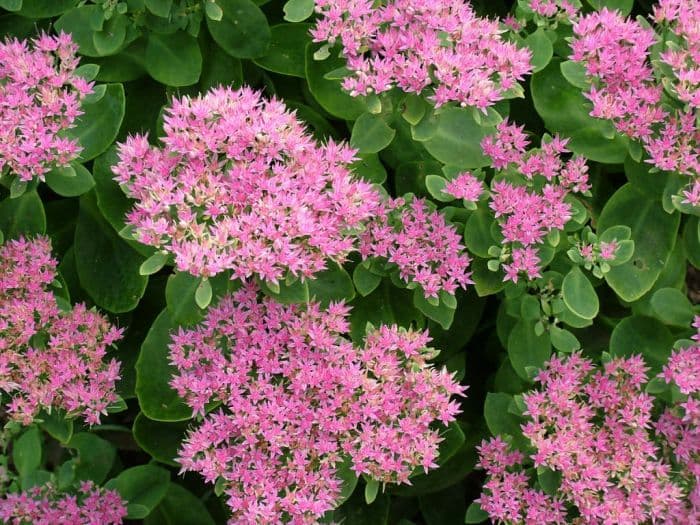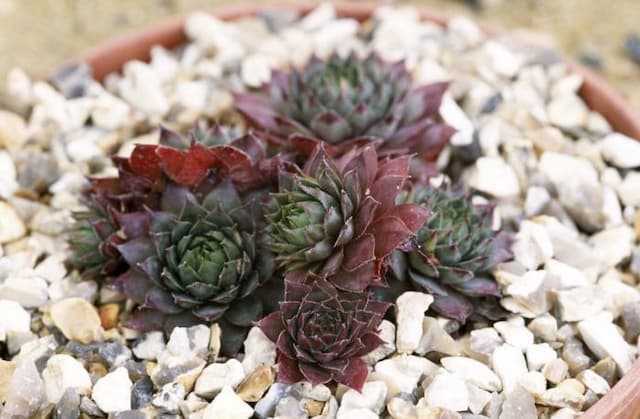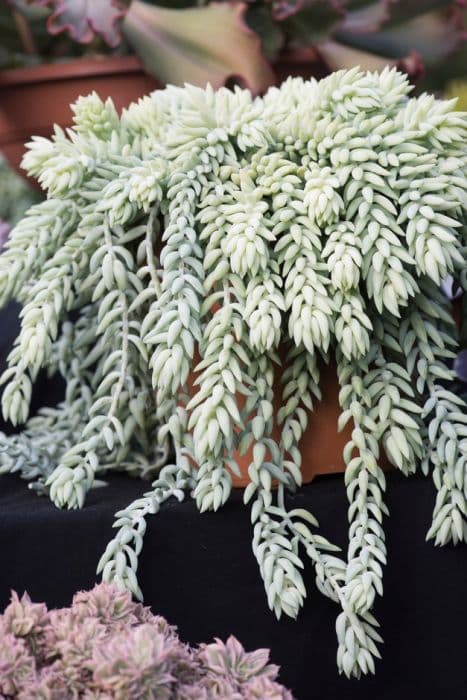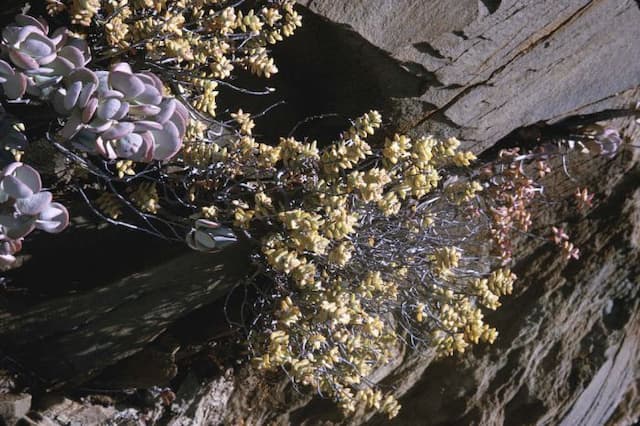Sedum Hylotelephium spectabile

ABOUT
Commonly known as the showy stonecrop, this plant is an eye-catching perennial that is admired for its striking foliage and flowers. The showy stonecrop typically has thick, succulent leaves that are a glaucous blue-green color, often with a slightly frosted or powdery look. These leaves grow in a dense, whorled pattern along the upright, unbranching stems, contributing to the plant's lush appearance. When it blooms, the showy stonecrop produces large, rounded clusters of tiny star-shaped flowers. These flowers are mostly a vivid pink to rosy-red hue, creating a bold contrast against the cooler tones of the foliage. The clusters of flowers form a domed shape at the top of each stem, giving the appearance of a colorful, floral umbrella. The blooms are highly attractive to pollinators, such as bees and butterflies, adding to the dynamic visual impact of the plant in a garden setting. Overall, the architectural form of the showy stonecrop, combined with its attractive foliage and brilliantly colored flower heads, make it a standout plant for adding texture and vibrant color to gardens and landscapes.
About this plant
 Names
NamesFamily
Crassulaceae
Synonyms
Showy Stonecrop, Ice Plant, Butterfly Stonecrop, Live Forever
Common names
Sedum spectabile, Sedum spectabile Boreau
 Toxicity
ToxicityTo humans
The plant commonly known as Stonecrop (specifically Hylotelephium spectabile) has a low level of toxicity to humans. While it is not considered highly poisonous, ingestion can lead to discomfort. Potential symptoms of Stonecrop poisoning if ingested may include mild gastrointestinal distress, such as nausea, vomiting, or diarrhea. As with any non-food plant, it is advisable not to consume any part of Stonecrop, and to keep it out of the reach of small children who might be tempted to ingest it.
To pets
The Stonecrop (Hylotelephium spectabile) is generally considered to have low toxicity for pets such as dogs and cats. However, ingestion of the plant can cause mild gastrointestinal upset in some pets. Symptoms of Stonecrop poisoning in pets may include vomiting, diarrhea, and lethargy. If you suspect your pet has ingested part of a Stonecrop plant, monitor for these symptoms and consult with a veterinarian if they appear ill or the symptoms persist.
 Characteristics
CharacteristicsLife cycle
Perennials
Foliage type
Deciduous
Color of leaves
Green
Flower color
Pink
Height
1-2 feet [30-60 cm]
Spread
1-2 feet [30-60 cm]
Plant type
Succulent
Hardiness zones
3
Native area
China Korea
Benefits
 General Benefits
General Benefits- Attracts Pollinators: The Hylotelephium spectabile, commonly known as Stonecrop, produces flowers that attract bees, butterflies, and other beneficial insects.
- Drought Tolerance: Stonecrop is extremely drought-tolerant, making it an excellent choice for water-conserving landscapes or areas with low rainfall.
- Low Maintenance: This plant requires minimal care once established, making it ideal for gardeners looking for low-maintenance options.
- Seasonal Interest: Stonecrop offers a variety of colors and textures throughout the year, providing visual interest across seasons with its flowers and foliage.
- Hardy Growth: It is a hardy plant that can survive in tough growing conditions, including poor soil, heat, and humidity.
- Frost Resistance: Stonecrop can withstand frost, making it suitable for gardens in cooler climates or as a perennial in zones 3-9.
- Erosion Control: The plant’s root system helps stabilize soil, making it useful for hillside plantings and erosion control.
- Edible Qualities: Some parts of the plant are edible and can be used in salads or as a garnish (though not commonly consumed, always ensure edibility before ingesting any plant).
- Architectural Structure: Its upright stems and symmetric flower heads provide an architectural element to garden design.
- Succulent Characteristics: As a succulent, it adds a unique texture and form to a succulent garden or mixed plant arrangement.
 Medical Properties
Medical PropertiesThis plant is not used for medical purposes.
 Air-purifying Qualities
Air-purifying QualitiesThis plant is not specifically known for air purifying qualities.
 Other Uses
Other Uses- Sedum spectabile, commonly known as "Stonecrop," can be used as a dye plant, as it yields a reddish-brown pigment suitable for textile dyeing.
- Stonecrop leaves are edible and can be used in salads or as a cooked green, providing a slightly sour or peppery taste.
- The thick leaves of Stonecrop can serve as a water source in emergency survival situations, as they retain moisture well.
- Stonecrop can be used in green roofing systems, where it helps in insulation and reducing stormwater runoff due to its succulence and hardiness.
- The nectar-rich flowers of Stonecrop attract bees and butterflies, making it an ideal plant for pollinator gardens.
- Stonecrop can serve as a ground cover to prevent soil erosion on slopes or in areas prone to land degradation.
- Stonecrop may be planted in containers and arrangements as "spillers" to create visual interest with their cascading habit.
- The dried flower heads of Stonecrop can be used in floral arrangements, providing visual appeal even in the off-season.
- Because of its thick foliage and growth habit, Stonecrop can be used to mark garden pathways or to delineate different sections of a garden without the need for hardscape materials.
- Stonecrop can be utilized in xeriscaping, helping to reduce water use in landscapes due to its drought-tolerant nature.
Interesting Facts
 Feng Shui
Feng ShuiThe Hylotelephium spectabile, commonly known as Sedum, is not traditionally used in Feng Shui practice.
 Zodiac Sign Compitability
Zodiac Sign CompitabilityThe Sedum is not used in astrology practice.
 Plant Symbolism
Plant Symbolism- Resilience: Hylotelephium spectabile, commonly known as "Stonecrop," is known for its hardiness and ability to thrive in rocky, challenging environments. It symbolizes the ability to survive and flourish under tough conditions.
- Perseverance: With its robust nature and tendency to grow in adverse conditions, Stonecrop represents perseverance and the determination to overcome obstacles.
- Well-being: The plant has been used in traditional medicine for its purported soothing properties, thus it can symbolize physical and emotional well-being.
 Water
WaterFor the Autumn Joy sedum, also known as Hylotelephium spectabile, it is essential to water moderately, allowing the soil to dry out between waterings. In general, water this plant every 7-10 days with about 1.5 gallons per square yard per watering session during its active growing season in spring and summer. Cut back on watering during the fall and winter months, limiting water application to just enough to prevent the soil from completely drying out. Avoid overwatering as it is susceptible to root rot, particularly in poorly drained soils.
 Light
LightAutumn Joy sedum thrives in full sun conditions where it can receive at least 6 hours of direct sunlight each day. The ideal spot for this plant would be in an area that is south-facing, ensuring plenty of light exposure throughout the day. While it can tolerate some light shade, too much shade will result in a leggy plant with weaker stems and less vibrant blooms.
 Temperature
TemperatureAutumn Joy sedum can survive in a range of temperatures but prefers the range between 65°F and 75°F. It can withstand winter cold down to about -30°F, making it quite frost hardy. During hot summers, it benefits from temperatures that do not often exceed 90°F. The plant is adaptable but may suffer in extreme heat without adequate water.
 Pruning
PruningPrune Autumn Joy sedum in late winter or early spring, before new growth starts. Pruning is done to maintain plant shape, remove dead or damaged stems, and encourage a more robust growth habit. Trim back the spent flowers and stems to the ground level. This typically only needs to be done once a year, as the dead stalks can provide winter interest and food for birds.
 Cleaning
CleaningAs needed
 Soil
SoilThe best soil mix for Showy Stonecrop is a well-draining, sandy or gravelly composition that is moderately fertile. A pH range between 6.0 and 7.5 is ideal for this succulent plant.
 Repotting
RepottingShowy Stonecrop should be repotted every 2 to 3 years to refresh the soil and to accommodate its growth.
 Humidity & Misting
Humidity & MistingShowy Stonecrop thrives best in low to moderate humidity levels and does not require high humidity.
 Suitable locations
Suitable locationsIndoor
Use well-draining soil and bright light for indoor Showy Stonecrop.
Outdoor
Plant in well-drained soil; full sun to partial shade for outdoor Showy Stonecrop.
Hardiness zone
3-9 USDA
 Life cycle
Life cycleThe Showy Stonecrop (Hylotelephium spectabile) begins its life cycle when seeds are sown in the soil and germinate, usually in spring, after experiencing cold stratification which breaks dormancy. Seedlings emerge and develop into rosettes of succulent leaves at ground level, drawing nutrients from the soil and undergoing photosynthesis. As the plant matures during its first or second growing season, it grows upward and forms a clump with stems that bear fleshy leaves, and eventually, it progresses to the flowering stage in late summer to early fall. The Showy Stonecrop produces clusters of small, star-shaped pink flowers that attract pollinators such as bees and butterflies, ensuring cross-pollination. Once pollinated, the flowers develop into seed capsules that release seeds when mature, completing the reproductive cycle. The plant may die back in winter, especially in colder climates, but it is a perennial and will regrow from the root system when conditions become favorable in spring.
 Propogation
PropogationPropogation time
Spring-Early Summer
The most popular method of propagation for Hylotelephium spectabile, commonly known as the Showy Stonecrop, is through stem cuttings. This is commonly done in late spring or early summer. Gardeners should select a healthy stem and make a cut about 4 to 6 inches long using a clean, sharp tool. After cutting, the bottom leaves are removed to expose a clear length of stem, which is then left to callous over for a few days to reduce the risk of rot when planted. The prepared cutting is placed in well-draining soil and kept in indirect light while keeping the soil consistently moist, but not waterlogged. Roots usually develop within a few weeks, at which point the new plant can be transferred to its final location.









